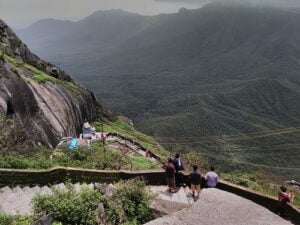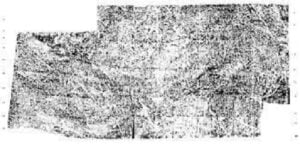Rudradaman I, a great ruler from the Western Kshatrapas dynasty, played a vital role in enhancing the dynasty’s reputation. This Junagarh inscription of Rudradaman is such a historical record that helps us to know the dynasty, especially King Rudradaman I. It is also known as ‘Junagarh Rock Inscription of Rudradaman’ or ‘Girnar Rock Inscription of Rudradaman’. Besides describing the King’s contributions and appearance, the inscription also sheds light on the Sudarshana Lake and its dam. Sudarshana Lake, from the period of Chandragupta Maurya, had been completely devastated by a storm and became stronger in Rudraman’s era. Within twenty lines, this inscription of Rudraman portrays all these things in a beautiful prose format.
Location:

We can find the Junagarh inscription to the east of the Junagadh town in the Kathiavad region of Gujrat, India. The inscription is carved on a big rock, close to the base of Girnar Mountain. Besides the Rudradaman’s inscription, this rock also contains two other inscriptions. Among them, the oldest one is the ‘edict of Ashoka’ and the last one is the ‘inscription of Skandagupta’. Therefore, this inscription of Rudradaman holds the second position in chronological older. The inscription is carved just above the Ashoka edict.
Discovery:

The Junagarh inscription of Rudradaman I was from 150 CE (approximately). The entire inscription is not in good condition. Evidence suggests that both the natural and willful acts damaged about 15% of total text.
In April 1838, James Prinsep first edited and translated the inscription. Thereafter, this attracted several scholars, including Wilson, Bhau Daji, and Fleet. Later, Kielhorn translated this inscription and that was published in Epigraphia Indica Volume VIII.
Characteristics of The Junagarh Inscription:

The Junagarh Inscription of Rudradaman I is in the Sanskrit language. And it uses prose format. It consists of 20 lines, and each inscribed characters are about 7/8 inches. The inscription covers the 5.5 ft by 11 ft surface of the rock.
In general, the text uses standard classical Sanskrit; however, it reflects many elements of non-standard Sanskrit also. According to Kielhorn, the inscription does not always follow the Sandhi rules of the Sanskrit language, possibly due to clerical errors. Besides, the text has an extreme lack of verbal forms that people used in early times. On the other hand, Salomon adds that it has inconsistencies in spelling regarding anusvara, visarga, double consonants, and the ‘!’ sound. Most probably, the influence of less formal and local dialect features is responsible for the errors.
Although the inscription does not strictly follow the classical Sanskrit grammar, it is nevertheless close to classical Sanskrit norms.
You can also visit Other Inscriptions in our page.
Facts Mentioned in The Junagarh Inscription:
The first 8 lines of the inscription mention the facts related to the Sudarshana Lake from Chandragupta Maurya’s time to around 150 CE. While the remaining 12 lines are all about King Rudradaman I and his good works. Here, we are going to learn some mentioned facts about the inscription in a simpler way. (Based on the Kielhorn’s translation).
About Lake Sudarshana:
| L1: | The inscription begins by praising the quality and maintenance of the Sudarshana Lake. In this line, the text highlights the Lake’s structural and functional features. The construction of the lake was very well, almost as solid as a part of a mountain. It is made of strong stone walls that are broad, long, and high without any gaps. Also, the lake has a natural dam with well-planned conduits, drains, and measures to prevent pollution. Besides these, the text also informs us that at that time, the Lake was in excellent condition. Most probably it is due to its mentioned features and other favours. |
| L3: | The Rudradaman I’s reign witnessed a severe flood that damaged the dam of the Lake. This section of the Junagarh inscription describes the result of the flood. Heavy rainfall caused the area to flood. The floods from the Suvarnasikata, Palasini, and other streams from Mount Urjayat were mainly responsible for the damage. The water churned by a storm was so fierce that all precautions were failed to manage it. The storm tore down hilltops, trees, banks, and even the raised places of shelters. Hence, the riverbed is filled with debris like stones, bushes, and creeping plants. |
| L7: | This line tells about a massive breach (420*420*75 cubic cubits) that was formed in the dam of the Sudarshana Lake. This breach or gap was responsible for a huge amount of water loss in the Lake. As a result, the Lake turned unattractive and almost like a sandy desert. |
| L8: | Here, the text explains the historical contributions of various rulers to the dam. Initially, it was built in the Maurya King Chandagupta’s reign. Vaishya Pushyagupta was in charge of the construction. Later, Yavanaraja Tushaspha improved it with channels during the Mauryan King Ashoka’s reign. This enhancement was crucial for the effectiveness of the dam. |
About King Rudradaman I:
| L9: | The following lines of the Junagarh inscription are entirely dedicated to King Rudradaman I. From here, the text starts to describe the king and his contribution to improve his Kingdom. This part of the inscription mentioned the King as Maha-kshtrapa Rudradaman. The king was known for his royal fortune and was respected by people of all castes. He made a vow to never take a person’s life except during battles. Throughout his life, he remained committed to this vow. In addition, He has expertise in various sciences and arts, including grammar, music, logic, and warfare. Rudradaman I ruled over a vast territory, including regions like East and West Malwa, Anarta, Saurashtra, parts of Gujarat, Marwar, and many more. Despite defeating Satakarni (Lord of Dakshinapatha) twice in a fair battle, he did not harm him because of their close relationship. He also achieved victory and reinstated dethroned kings. These incidents also played a major role in earning positive reputations. The inscription mentions another significant incident of Rudradaman I’s period. That is the reconstruction of the mentioned dam. He not only repaired the dam but also made it thrice as strong as before. Furthermore, he accomplished this without burdening his people with heavy taxes or forced labor. He spent a large amount of money from his treasury to strengthen the dam and beautify the Sudarshana Lake. |
| L16: | In this section, the text introduces a wise minister named Suvishakha (a Pahlava). King Rudradaman I appointed Suvishakha to govern Anarta and Saurashtra. When the advisors and officers of the king hesitated to repair the dam due to its extensive damage, Suvishakha carried out the reconstruction process. He was an honest, humble, and incorruptible person. Furthermore, he was well known for his wise and fair rule. According to the inscription, besides benefiting the people, his good governance also enhanced the reputation and honor of the King. |
Although the entire inscription has not been discovered, the portion we have is enough to understand the dynasty and the mentioned ruler. Like other inscriptions, this rock inscription also offers insights into the social, political, and literary landscape of the time. But, what makes it more significant is the brief mention of Sudarshana Lake of the Mauryan Period. Thus, undoubtedly, the Junagarh inscription of Rudradaman is a precious document of India’s ancient history.

